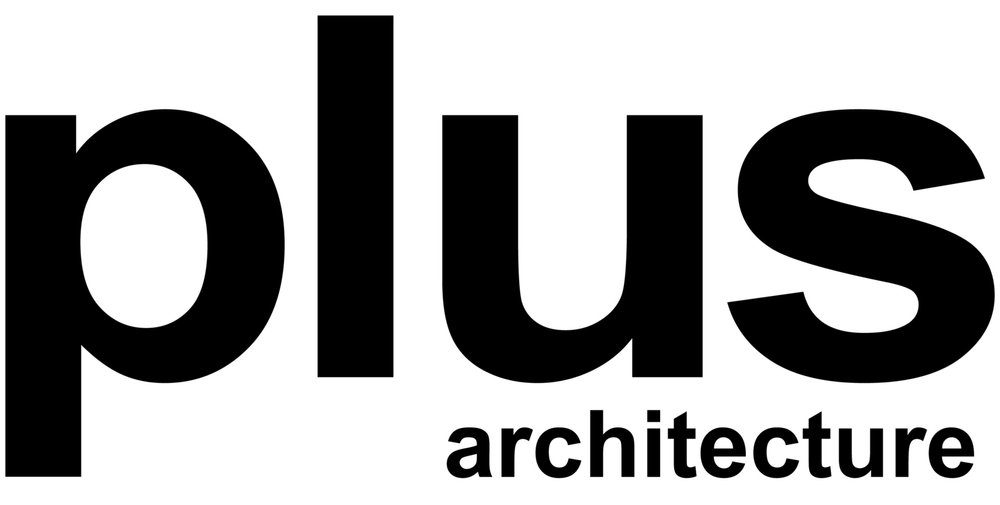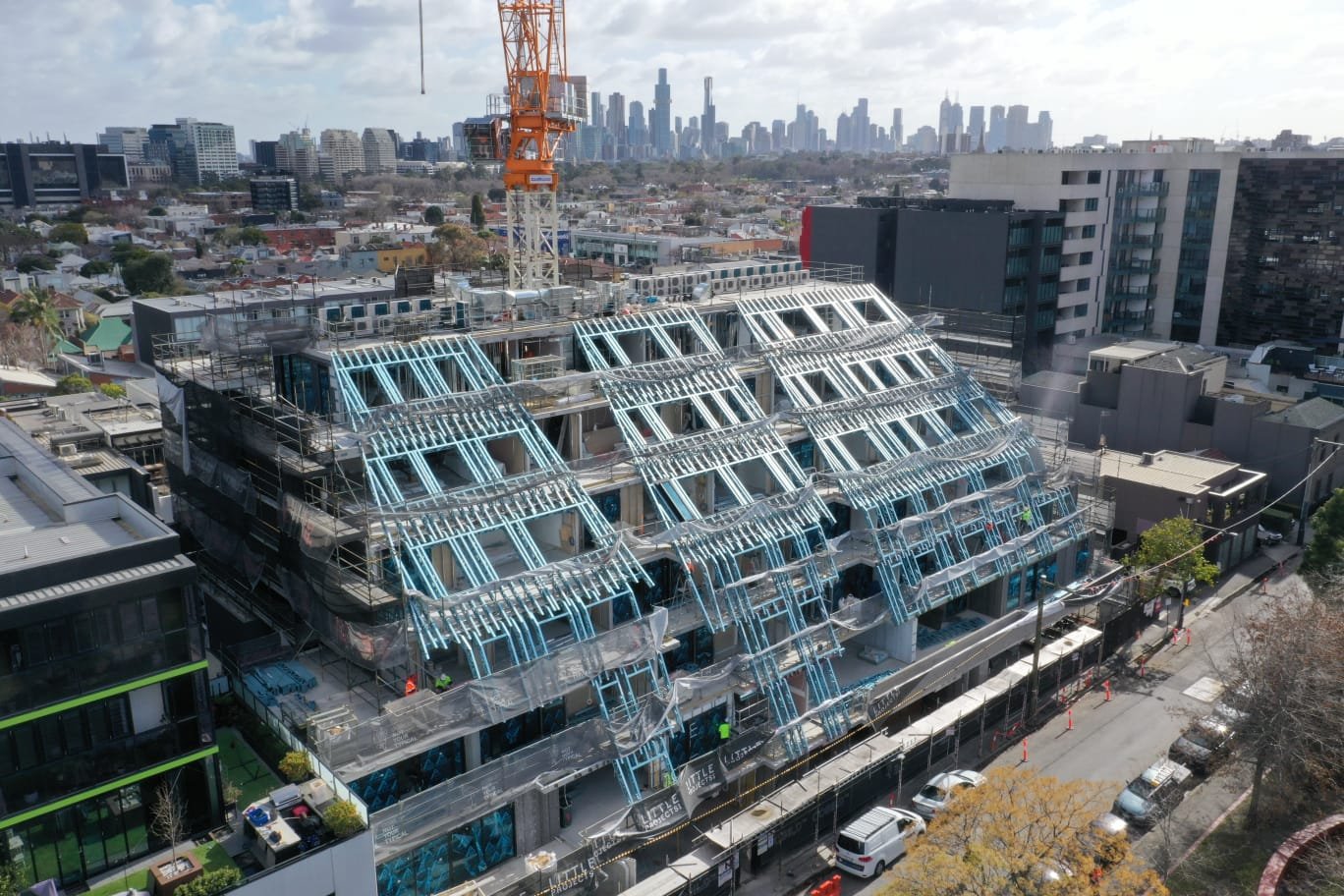Viridi
CLIENT | Little Projects
TYPE | Architecture, Interior Design, Documentation
SECTOR | ReSIDENTIAL
STATUS | Complete (2022)
LOCATION | Prahran, VIC
HEIGHT | 24 M, 7 Storeys
SCALE | GFA: 7,777 sqm, Site 1,566 sqm, 43 apartments
PHOTOGRAPHY | Tom ROE
AWARDS
2023 Think Brick Awards - Roof Tile Excellence - High Commendation
2023 The urban developer awards - excellence in design innovation - finalist
2022 UDIA VIC Awards for Excellence - Design Excellence - Finalist
2022 Victoria Steel Excellence Awards - Innovative Cold Form Steel - Winner
2022 Australian Steel Excellence Awards - Innovative Cold Form Steel - Winner
An eye-catching multi-residential development in the sought-after Melbourne suburb of Prahran.
Echoing the contours of its landscape, Viridi appears to gracefully emerge from its surroundings. Contributing a dynamic visual landmark to the site, the mosaic-like tessellation of thousands of tiles glint and ripple across the crafted façade. Nestled between South Yarra and Windsor, this project aims to set the tone for Viridi to become a diverse neighbourhood, welcoming individuals, couples or young families.
Initiated by Little Projects and the landowner, the project sought to deliver an enticing multi-residential experience with 43 dwellings that would be highly sought after by owner-occupiers. We were briefed to provide a design for an oddly-shaped 1566 sqm site, that would not overshadow Grattan Gardens nor the surrounding pedestrian ways, aiming to usher in as much daylight as possible throughout the year. This complex brief, and our innovative visual response, prompted much early collaboration to ensure that the novelty of the build would still produce a viable outcome for the client.
In the earliest stages of design, our team spent time on site taking in the nuances of the context. This considered observation of the gardens and heritage cottages informed our conceptual direction, whereby the rhythm of the park, adjacent to the project site, sweeps up, creeping like a vine over the organic hill-like form. Although visually complementary to the lush natural surrounds with its uniquely tiled facade, the sloping form avoids overshadowing the park and footpaths, embedding itself rather than imposing upon the streetscape.
The heavily varnished glossed tiles of the façade, while applied to a contemporary design structure, are synonymous with the heritage hotels and public Australian buildings. This external palette ebbs and flows between lush greens and earthy hues.
The façade lends an utterly magical element to the project. Although a seamless result, the tiling was extremely complex. Initial stages involved exploring tiles of various weights and shades. Shades would need to mimic the surrounding parklands, while the structure would need to support the weight of the thousands of selected tiles. Our team conducted extensive investigations into various manufacturing options that would be suitable visually and structurally. Over 2000 terracotta roof tiles, glazed in coats of earthy and lush greens were sourced from Spain in three shades, an outcome impossible without the close working relationship of the client, Plus and the builder Cobild.
The façade design was executed over several intricate stages in order to achieve the overall movement and impact. The core idea was to create the perfectly organic hedge-like tonal gradients by using just the right ratios of each of the three hues of glazed terracotta tiles. The renderer creating the 3D models was given various ratios of each tile colour to work with. Persistent trialling eventually resulted in the beautifully mottled effect apparent in the outcome.
Once the ratios of each tile colour were determined, the titles had to be mapped for the builder - a process akin to placing pixels one-by-one. Paradoxically, a randomised pattern was achieved through precisely modelled precision.
Rather than shy away from the challenges of the bizarrely shaped site and a requirement to avoid overshadowing, we reframed them as opportunities for innovative thinking and a novel solution. However, the novelty of the build required an intensely collaborative nature between our design team, builders, roofing contractor, tiler and façade engineers to ensure that the integrated façade was realised to the applicable standards. It was a hands-on process, with our team involved at every stage from laying out tiles to fixing them in place.
Throughout the construction process, Cobild was exceptional when working with the Plus design team and collaborating on the complexities of the façade construction methodology. Through numerous workshops and liaising with expert façade engineers Inhabit, Cobild and Plus Architecture developed a facade system that is unique to the Prahran skyline.
The truss system developed by Bolt Blue Constructions and Dynamic Steel Frame will ensure adequate stability for the windows and tiles, whilst also ensuring the raked form and angles will be achieved. The truss system is fixed to post-tensioned slabs, which allowed greater flexibility in achieving the unique design whilst also ensuring rigidity.
PHOTO: Bolt Blue Constructions
The angular façade, although avoiding overshadowing externally, internally, presented challenges to interior amenity. Risk was mitigated throughout the development by ensuring there was tolerance within the facade design that allowed for ample height of bedrooms that would be most impacted by the curved form. The result allows these rooms immersive vistas of the skyline.
With natural light a priority the weight of windows, some reaching over 500kg, and the need for them to meet the FP1.4 waterproofing compliance standards, presented a structural challenge. We resolved this by adopting a traditional stick build methodology, whereby a blue steel frame was used to deliver structural efficiency and facilitate an effective tiling approach that reduced the overall thickness of the façade.
Passively sustainable elements are embedded within the design from the double-glazed windows to the thermal insulation that results from the façade itself.
Developed during a COVID-19 era, the project and collective teams involved were subject to the ever-changing onsite conditions of the pandemic. Additionally, supply chains were heavily impacted. Despite this, we were able to deliver the project to budget within the desired timeframe. From client through to contractor, every party worked cohesively, striving for the best outcome.
Viridi exemplifies design that paradoxically succeeds in both uniting with its surroundings while also distinctly enhancing them. The captivating façade, with its dynamic, tactile and reflective surface, shifts and shimmers responsively to transitions from day to night. Reaching beyond standard multi-residential design, this unique outcome is a catalyst for life, contributing vibrant character to place.
FEATURED
Viridi Residential Building / Plus Architecture, Archify
Viridi Residential Building / Plus Architecture, Archdaily
Steel-Framed Facade Adds ‘Magical Element’ to Multifamily Project, Build Steel
Prahran’s Viridi seven-star energy efficient apartments go green literally, News.com.au
Plus Architecture sets facade design technology benchmark, Build Australia
Viridi Apartments in Prahran, Melbourne, e-Architect
Plus’ innovative facade recognised as first of its kind, Architecture and Design
Extraordinary façade at Grattan Street, Plus Architecture
Paul Little teams with property owner to redevelop prime Melbourne site, Real Estate Source








